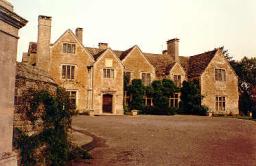Biography of John Freke
John Freake was born in 1631 and baptized on July 3 at the manor house Hinton St. Mary, Dorset County, England (fig. 1).
He was the third child of Thomas (1598–1642) and Mary Dodington Freke (d. 1686), a landed family of Hinton.
John's grandfather was Sir Thomas Freke (1563–1633), who was knighted by James I, served twice as a member of Parliament for Dorset, and for thirty years was a deputy lieutenant of the county of Dorset.
In 1610 Sir Thomas paid to build the parish church at Shroton, also called Iwerne Courtney, Dorset County, where he was later buried under the family coat of arms.
John Freake's grandfather also participated in colonial ventures as a member of the king's Council for Virginia (1607) and the council for the Virginia Company (1612).
A portrait of Sir Thomas Freke remains in the family, and portraits of John Freake's uncles, Raufe Freke (1596–1683/4) and William Freke (1605–1656), hang in the Bodleian Library, Oxford University.
Photograph of John Freake’s birthplace, Hinton St. Mary Manor House, Dorset, England.
John emigrated from England by 1658 and became a successful merchant and attorney in Boston.
His family background suggests that he brought significant financial and other resources with him from England. John married Elizabeth Clarke (1642–1713) in Boston on May 28, 1661.
The couple settled in Boston's North End, and between 1662 and 1674 they had eight children.
John Freake held public office in his adopted city as a juryman and a constable and also served as a trustee of the Second Church (Puritan) of Boston.
Shortly after his arrival from England Freake became a business associate of Captain Samuel Scarlett (d. 1675).
In 1669 Freake and Scarlett jointly purchased waterfront property at the "Sea or Harbor of Boston", including "the Ware-Houses Edifices, buildings shops Sellers, rent & Rents" belonging to it.
In 1671/2 Freake and his partner were granted permission to maintain a wharf in front of their property for twenty years, and they were to be compensated by the city five shillings per year for maintaining the causeway.12 Their joint business holdings eventually included a dock, wharf, warehouses, dwelling houses, and a barge.
John Freake was a man who pushed boundaries. In 1666 he supported recognition of King Charles's commissioners in Boston, a direct challenge to the authority of the Puritan government of the colony.
He signed a petition in 1673 to have letters of reprisal issued after seven armed merchant ships were lost during the third Anglo-Dutch War (1672–1674).
Because of his and other merchants' opposition to local authority in 1666, the General Court denied their request.16 Despite the continuing risks of attack by Dutch ships, Freake traded in Acadia (Maine) in the waning years of the third Anglo-Dutch War.
Recognizing the danger to his livelihood, Freake tested the political resolve of the colony late in 1674 by sending his bark Philip to Maine on a trading voyage. The Philip was seized at anchor near Mount Desert by a Dutch privateer, and Freake petitioned the General Court to recover the lost vessel.
This time the colonial government supported Freake by commissioning Capt. Samuel Moseley, who would soon earn a reputation for daring as a privateer and soldier during King Philip's War, to retrieve Freake's bark.
Moseley apprehended those responsible for capturing the Philip and they were charged in Boston for "pyrattically and felloniously seize[ing] & take[ing] seuerall smale vessells," including "the barcque Phillip & her Goods" and "wounding" the ship's master and mate.
On May 4, 1675, before the trial of the Dutch privateers took place, John Freake died accidentally on board another one of his ships that had just arrived from Virginia. The diarist Samuel Sewall (1652–1730) recorded the accident: "Tuesday, May 4 Cpt Scarlet, Mr. Smith, Mr. Freak killed by a blow of powder on Ship board. Mr. Freak killed outright."
Rev. Simon Bradstreet expanded upon Sewall's version of the accident: "Mr. Freak and Capt. Scarlett of Boston were killed by ye blowing up of ye deck of a ship by ye Carelessness of some aboard. There were diverse others that wr very dangerously wounded and some of yem after dyed."
Scarlett lived long enough to prepare a will, in which he named John Freake, Jr., as a beneficiary. Scarlett also left annual gifts to the Second Church, Harvard College, and for the relief of the poor in his native town Kersey, Suffolk County, England.
John Freake's probate inventory lists real and personal property worth nearly two thousand four hundred pounds, a substantial estate for the late seventeenth century. His holdings included partial ownership of six ships valued at a total of six hundred and one pounds; half interest of the land, houses, wharf, and dock owned presumably with Samuel Scarlett at four hundred fifty pounds; one eighth of the "millnes in Boston" at four hundred pounds; the Freakes' "dwelling house ould & new with ye land" four hundred fifty pounds; one-fifth of a brew house and land at Fort Hill at one hundred fifty pounds; silver plate at sixty-eight pounds; and a servant or slave listed as "One Negroe named Coffee" at thrity pounds.
Freake was buried in the Granary Burying Ground in Boston, and his tomb bears a coat of arms that combines the Freake family arms used in Shroton, County Dorset, England, with the Clarke coat of arms for his wife, Elizabeth.

